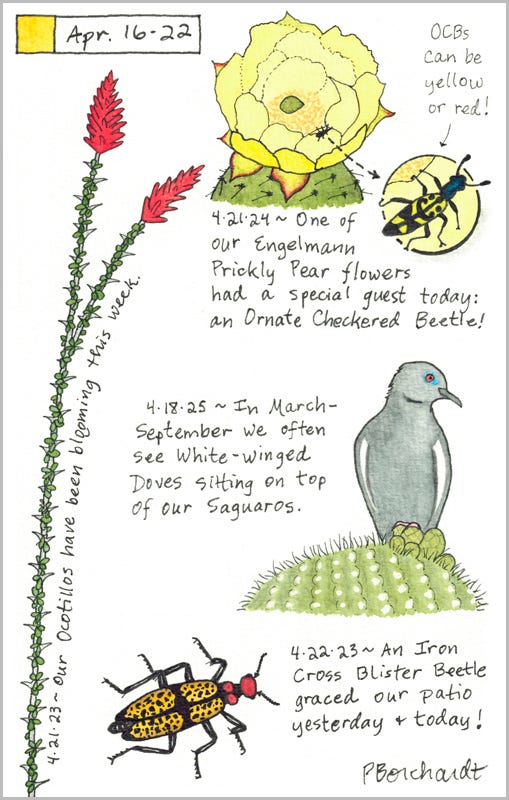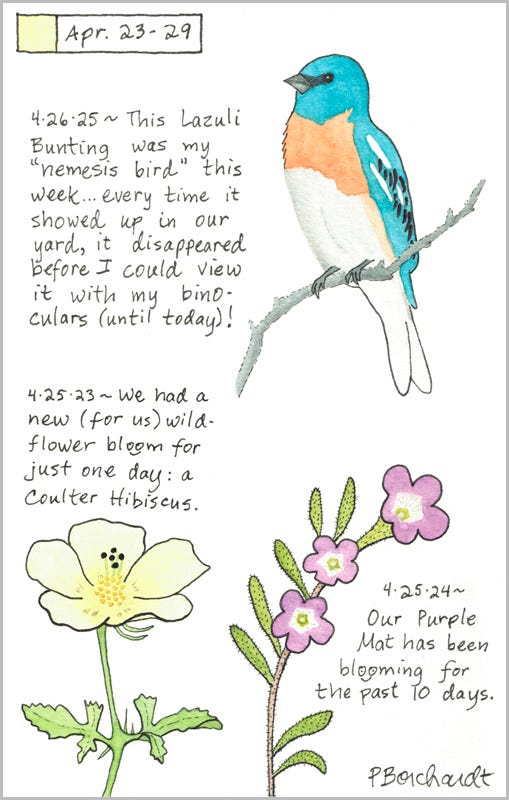Today’s post continues my bird mini-series and features three species of birds, lots of flowering plants and a couple of cool insects.
First, here’s my Perpetual Journal page featuring a White-winged Dove.

Although we observe Mourning Doves pretty much year-round in our yard, we only see and/or hear White-winged Doves from March through September—as you can see in this nifty chart that eBird provided to Hubby, based on Hubby’s eBird checklists.

Hubby is definitely the Senior Birder in the household (I am but a Junior Birder in comparison). Hubby recently reached an eBird milestone of 1000 checklists submitted and currently has an eBird checklist streak going of over 425 days in a row! Go Hubby! Wowzer!!!
🧐 A Fun Fact about White-winged Doves
Here in the Sonoran Desert, nesting White-winged Doves are so dependent on Saguaros for food—they consume the nectar, pollen, fruit, and seeds—that they time their migration and nesting to match Saguaros’ fruiting schedule.
You can learn more about White-winged Doves at All About Birds.
Regarding the cool insects on my PJ page above, I specifically looked for Ornate Checkered Beetles on our Prickly Pear this Spring, and found just a few. We haven’t seen any more Iron Cross Blister Beetles, however, since the momentous occasion in 2023 that I chronicled in my PJ.
Here’s my Perpetual Journal page from a week later, featuring a Lazuli Bunting.

In my PJ text I described this Lazuli Bunting as my “nemesis bird” and yes, that really is a thing! Every time Hubby & I were outside that week and he said “Look—there’s a Lazuli Bunting!” by the time I got my binoculars in the vicinity of the bird, the bird had either flown off or had moved to such dense foliage I couldn’t see it. I got discouraged and stopped looking every time Hubby pointed it out. 😕 Finally, though, I was able to “glass” it, getting a good look through my binoculars—hooray! Males like this one (in breeding plumage from April-September) really are beautiful birds! In fact…
🧐 A Fun Fact about Lazuli Buntings
Early naturalists called Lazuli Buntings Passerina amoena which means “beautiful sparrow”.
You can learn more about Lazuli Buntings at All About Birds.
Here’s my next week’s PJ featuring a Western Kingbird along with a Saguaro and Palo Verde in bloom.

Saguaros and Palo Verdes are considered keystone species for the Sonoran Desert. If you’re not familiar with this term, here’s a description from NRDC:
Keystone Species
A keystone species—which can be any organism, from animals and plants to bacteria and fungi—is the glue that holds a habitat together. It may not be the largest or most plentiful species in an ecological community, but if a keystone is removed, it sets off a chain of events that turns the structure and biodiversity of its habitat into something very different.
🧐 A Fun Fact about Western Kingbirds
Western Kingbirds were originally known as Arkansas Kingbirds, but scientists changed the name to acknowledge these birds’ wide range across western North America.
You can learn more about Western Kingbirds at All About Birds.
👍 A Thank You
Another artist, Carolyn Sehgal, gave me a nice shout-out this past week on her blog post Starving Artist vs. Thriving Artist: Which one am I?. Thank you, Carolyn! 😃 Carolyn alternates her posts between “Failing Creatively” (art-related) and “Art & Good News” (a weekly roundup of her art and uplifting stories). Art and positivity—what’s not to like?
“A bird does not sing because it has an answer. It sings because it has a song.”
- Chinese Proverb
You can leave a comment or ask a question…
…and if you’ve enjoyed this, please share this post with friends, family and the world! 😃



Both the common and scientific names of the Lazuli Bunting seems accurate. Wonderful work as always.
Besides learning about your lived experience and interesting things to know about nature in your surroundings, I am always captivated by your art presentation. So beautiful, all of it.